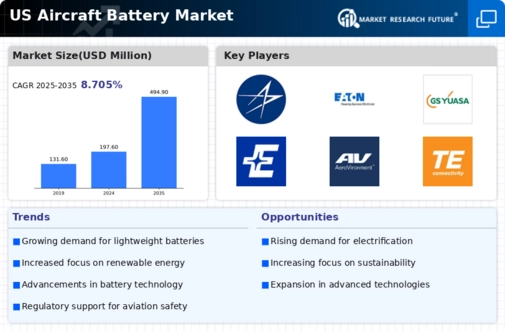Focus on Enhanced Safety Features
Safety remains a paramount concern in the aviation industry, influencing the aircraft battery market significantly. Manufacturers are increasingly prioritizing the development of batteries with enhanced safety features, such as thermal stability and fire resistance. This focus is driven by the need to mitigate risks associated with battery failures, particularly in high-stakes environments like aviation. In 2025, it is estimated that batteries with advanced safety features will represent around 35% of the aircraft battery market. The emphasis on safety not only aligns with regulatory requirements but also addresses consumer concerns, thereby fostering trust and confidence in the aircraft battery market.
Growing Demand for Lightweight Batteries
The aircraft battery market is experiencing a notable shift towards lightweight battery solutions, driven by the aviation industry's need for improved fuel efficiency and performance. Lightweight batteries, such as lithium-ion and lithium-polymer, are increasingly favored due to their high energy density and reduced weight. This trend is particularly relevant as airlines seek to minimize operational costs and enhance aircraft range. In 2025, the market for lightweight batteries is projected to account for approximately 40% of the total aircraft battery market, reflecting a significant increase from previous years. The emphasis on reducing aircraft weight aligns with broader industry goals of enhancing sustainability and operational efficiency, thereby propelling the growth of the aircraft battery market.
Increased Investment in Electric Aviation
Investment in electric aviation is surging, which is likely to have a profound impact on the aircraft battery market. Major aerospace companies and startups are channeling substantial funds into the development of electric and hybrid aircraft, necessitating advanced battery systems that can meet the unique demands of these vehicles. In 2025, investments in electric aviation are expected to exceed $5 billion, reflecting a growing recognition of the potential for electric aircraft to revolutionize air travel. This influx of capital is anticipated to accelerate innovation in battery technologies, thereby expanding the aircraft battery market. The focus on electric aviation aligns with broader trends towards decarbonization and sustainable transportation.
Rising Demand for Unmanned Aerial Vehicles (UAVs)
The aircraft battery market is experiencing a surge in demand for batteries used in unmanned aerial vehicles (UAVs). As UAV applications expand across various sectors, including agriculture, surveillance, and logistics, the need for reliable and efficient battery systems becomes increasingly critical. In 2025, the UAV segment is projected to account for approximately 25% of the aircraft battery market, driven by advancements in battery technology that enhance flight duration and payload capacity. This trend indicates a shift in market dynamics, as manufacturers adapt to the specific requirements of UAVs, thereby fostering innovation and growth within the aircraft battery market.
Regulatory Support for Advanced Battery Technologies
Regulatory frameworks in the US are increasingly supportive of advanced battery technologies, which is likely to bolster the aircraft battery market. The Federal Aviation Administration (FAA) has established guidelines that encourage the adoption of innovative battery solutions, particularly those that enhance safety and performance. As regulations evolve, manufacturers are incentivized to invest in research and development of next-generation batteries, such as solid-state and hybrid systems. This regulatory support is expected to drive market growth, with projections indicating that advanced battery technologies could capture up to 30% of the aircraft battery market by 2027. The alignment of regulatory policies with technological advancements suggests a promising future for the aircraft battery market.


















Leave a Comment